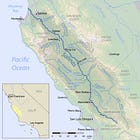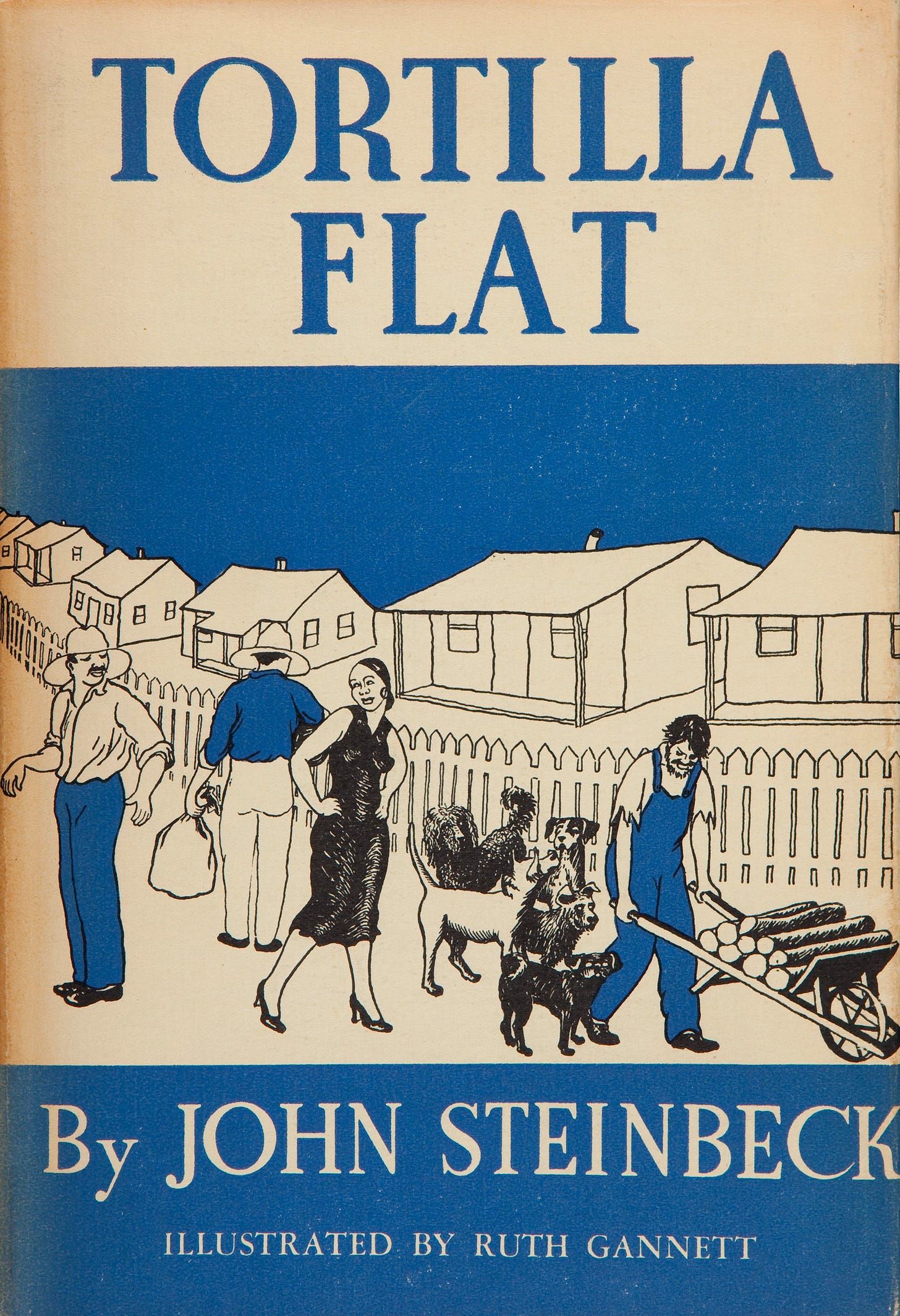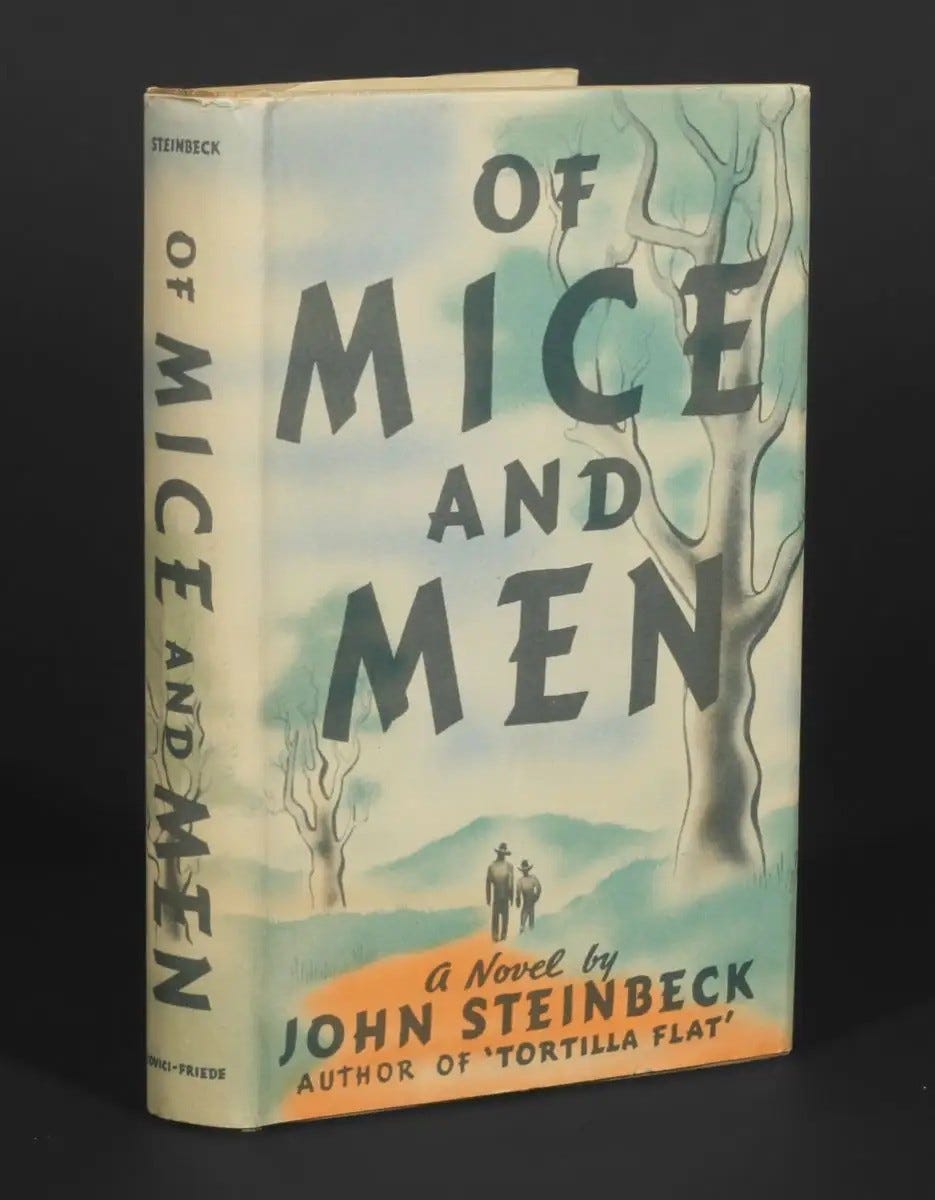The Steinbeck Review #3 - My Brother's Keeper
Tortilla Flat | In Dubious Battle | Of Mice and Men
“In every bit of honest writing in the world there is a base theme. Try to understand men, if you understand each other you will be kind to each other. Knowing a man well never leads to hate and nearly always leads to love. There are shorter means, many of them. There is writing promoting social change, writing punishing injustice, writing in celebration of heroism, but always that base theme. Try to understand each other.” - John Steinbeck
If you have recently joined us, Part 1 of this series can be found here:
Steinbeck was hitting his stride as a writer, and with four published books under his belt, his unique voice took hold in his work. While the country was in the midst of the Great Depression, Steinbeck’s parents died within a year of each other. He turned to writing as a means to clear away the fog of pain. Between 1935 and 1937, he published three more books: Tortilla Flat, In Dubious Battle, and Of Mice and Men. These stories feature the scenic vistas of central California, a strong focus on agriculture and migrant workers, and intriguing characters often forgotten by society, all of which were mainstays of Steinbeck’s writing. The books received positive reviews from readers and critics alike, and each was later adapted for film.
Steinbeck continually draws attention to the inherent value of people, particularly those at the margins of society. He builds on his Phalanx philosophy, examining “group think” and how reactionary behavior impacts the individual who is powerless against the herd. Does the dream of an individual have value? Do dreams give our lives meaning? What obstacles does society place in the path of the personal dream? These are all questions posed to us in the context of these stories.
“The afternoon came down as imperceptibly as age comes to a happy man.” - Tortilla Flat
Tortilla Flat is the story of Danny and his paisano friends. These individuals of mixed Mexican, Indian, Spanish, and Caucasian heritage operated outside the normal confines of society, ostracized by other ethnic groups. They made their home in the fictional Tortilla Flat, a barrio of Monterey. The collective of big-hearted ruffians, thieves, and drunkards, make their home together in Danny’s house, inherited from his grandfather after a stint in the army. This house became the nexus for numerous adventures and shenanigans, some noble and some not, upon which they would embark. “For Danny’s house was not unlike the Round Table, and Danny’s friends were not unlike the knights of it.”
The novel was a hit, bringing Steinbeck financial success and cementing his name in the annals of American Literature. The San Francisco Chronicle called it “exceptionally fine,” and the Saturday Review said it had “facile style and whimsical humor underlying its sharp and clean-cut presentation of character.” Thomas Finsch said the book offered “escapism and entertainment” during the Great Depression. Humor was a central aspect of Steinbeck’s work, prompting the Nobel Prize committee to commend him later in his career for “sympathetic humor” in his observation of the human condition.
Some readers did not find humor in the story; instead, they experienced a sad journey into darkness. Critics called out the perceived stereotypical representation of Hispanics as bums who were allergic to work and unconcerned with hygiene. Some questioned how a white, middle-class male could knowledgeably write about a minority community without having lived their experience. In the 1970s, Professor Philip Ortega would state, “to believe Steinbeck’s descriptive diagnosis of the Chicano ethos in Tortilla Flat is to reinforce the most prevalent stereotypes and caricatures about Chicanos.”1
Despite its lamentable ending, Tortilla Flat remains one of Steinbeck’s most enduring novels. Educators have frequently added it to their curriculum due to its relatively short length and intriguing cultural discourse. Whether Steinbeck’s representation of the paisano subculture is accurate, there is little doubt that he had strong positive feelings for these individuals. In the preface of one early edition of the book, he claimed that he had a special place in his heart for the paisanos and wanted to write about their carefree, happy-go-lucky way of life. Steinbeck continued building on his trademark themes in this story, and despite its tragic nature, it is filled with a sense of poignant hope.
“Out of all this struggle a good thing is going to grow. That makes it worthwhile.”
Steinbeck spent years interviewing laborers before writing In Dubious Battle and claimed this was the first book where he could take the time to write the story he wanted. Writing to his friend George Albee, he expressed his desire to explore man’s self-hate and saw this work as an attempt to reconcile man’s conflicting natures of destruction and love.2 Loosely based on historical events, the story follows “Party” agents who take advantage of a wage cut to arrange a strike among migrant fruit workers in California.
The book received critical acclaim, with The New York Times calling it “the best labor and strike novel to come out of our contemporary economic and social unrest.” At the same time, the Washington Post said it was “primarily a work of fine craftsmanship and secondly a strong, proletarian outcry.” Often considered a forgotten classic, it has been overshadowed by later works, primarily The Grapes of Wrath, which focused on similar ideas and characters.
Steinbeck found his voice by speaking consistently and strongly about workers’ rights. Each new story brought to life the plight of the migrant worker against the backdrop of the agricultural landscape in Depression-era California. The character Jim provided an opportunity for Steinbeck to explore the struggle with personal identity when faced with overwhelming group pressure. He used that as a catalyst to examine further the Phalanx concept, his philosophical theory of “group think.” Steinbeck’s fascination with group behavior, what sociologists term “bionomics,” drove him to spend time with workers in adverse situations. Despite his interest in group behavior, his writing often focused on social inequality and human rights, as these were the issues his readers, including many activists inspired by the work, cared about.
The book has been construed as supportive of Communist ideals in questioning the viability of capitalism and an economic system oppressive of its labor force. However, Steinbeck was clear that he was also questioning the motives of Party members, mainly when the character Mac manipulates situations to his advantage to achieve his desired goals, not necessarily those of the workers. The story ends on a dark and violent note, for which Steinbeck was criticized. Unfortunately, violence was a part of the landscape, as evidenced by the longshoreman strike of 1934, which came to be known as “Bloody Thursday.”3
I struggled with the pacing and repetitiveness of this book, feeling it could have been half the length and still told the story. Even so, the writing is the work of a master at his craft, simply not up to the same level as some of his other works.
“I got you to look after me, and you got me to look after you...” - Of Mice and Men
Steinbeck wrote several novellas in a style he envisioned to be read as a book or performed as a play. The most famous of these, Of Mice and Men, is one of his most acclaimed and beloved works. The Book of the Month club selected it as their monthly offering, and critics raved about it upon release. This concise literary masterpiece wastes no words in telling the profoundly moving story of two migrant workers, George Milton and Lennie Small, who have been friends since childhood.
Set in California during the Great Depression, the dichotomy of weak versus strong resonates in each line. George is “small and quick,” with every angle of his features defined. Lennie is big and strong with the mind of a child. George has cared for Lennie since they were young, and all the years they have traveled the roads together since. A complicated past and hopeful future frame their unlikely friendship. This inseparable duo attempts to claw a better life out of the earth in a world of solitary men where loneliness abounds.
Each character is filled with aspirations, hopes, and dreams of something more. George and Lennie dream of a small house on a few acres with a garden, animals, and rabbits. This unfulfilled desire is that which they struggle towards, the insatiable desire for a place to belong, seemingly out of reach and unattainable except in the ephemeral recesses of their dreams.
Steinbeck returns to familiar themes of agriculture, migrant workers, and class power struggles while expanding on the idea of loneliness. Set near Soledad, meaning solitude in Spanish, societal barriers artificially maintain loneliness in a deliberate action of power over the powerless. Economic and intellectual power is used to maintain control of the working class through oppression and abuse, allowing Steinbeck to call attention to inequality between workers and landowners.
Originally titled Something that Happened, Steinbeck modified the title after reading the poem To a Mouse, written in 1785 by Robert Burns. In the penultimate stanza, the following line appears: “The best-laid schemes o' mice an' men Gang aft agley” which translated into modern English reads “The best laid plans of mice and men often go awry.”4 The tragic ending calls to mind the story of Cain and Abel, compelling us to ask, “Am I my brother’s keeper?”
I would love to hear from you in the comments. Have you read anything by Steinbeck? What was your impression? Any favorites?
Until next month…
Fables of Identity: Stereotype and Caricature of Chicanos in Steinbeck’s Tortilla Flat - Journal of Ethnic Studies Vol. 1, 1973
John Steinbeck, Writer: A Biography by Jackson Benson – December 1, 1990
https://www.ilwu.org/bloody-thursday-1934-the-strike-that-shook-san-francisco-and-rocked-the-pacific-coast/
https://en.wikipedia.org/wiki/To_a_Mouse










Thank you for this well-research series on Steinbeck and his books. To answer your question, my favorite is East of Eden. But then I have only read nine. How many books has he written?
Really enjoyed this, one of my all time favorite authors. His stories and observations and take on places, time, people register with this Californian and brings her back home to those he describes. Thank you. Glad to have found your writing.